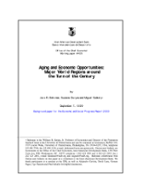Aging and Economic Opportunities: Major World Regions around the Turn of the Century
Date
Sep 1999
This paper presents new evidence for major world regions and for the most populous countries in each region on associations between the average ages of populations and three groups of economic outcomes: (1) macroeconomic aggregates (domestic saving as a share of GDP, GDP per capita, capital per worker and tax revenue as a share of GDP); (2) governmental expenditures on education and health; and (3) social indicators (inequality, unemployment, homicide rates, and schooling progression rates). The results suggest that the variables considered follow clear age-related patterns, that the patterns differ by regions, and that the patterns differ with different policy regimes related to trade openness, domestic financial market deepening and macroeconomic volatility. The evidence is consistent with the possibility that some age structure shifts can provide favorable conditions for development. Apparently regions such as East Asia in recent decades have been able to benefit from this demographic opportunity. However, in others such as Latin America and the Caribbean -which is at the verge of experiencing the largest age structure shifts in the coming decades- creating an adequate economic environment to translate the opportunity into higher living standards for its population is a major challenge.



